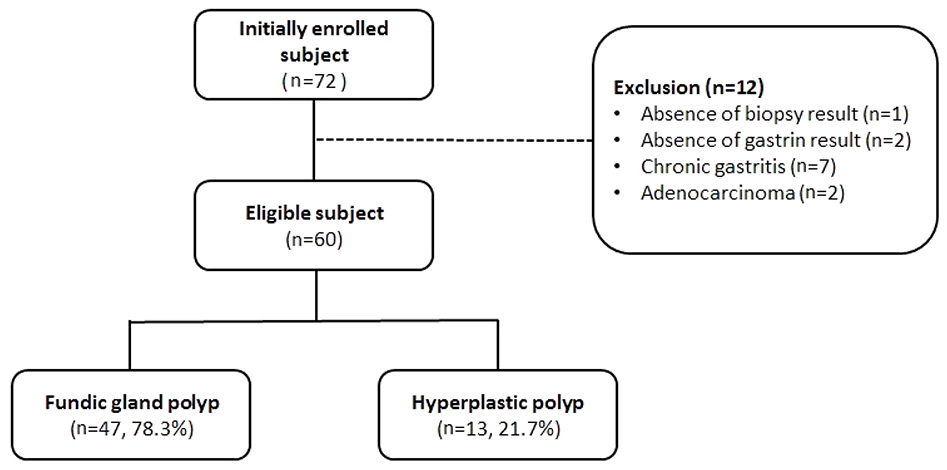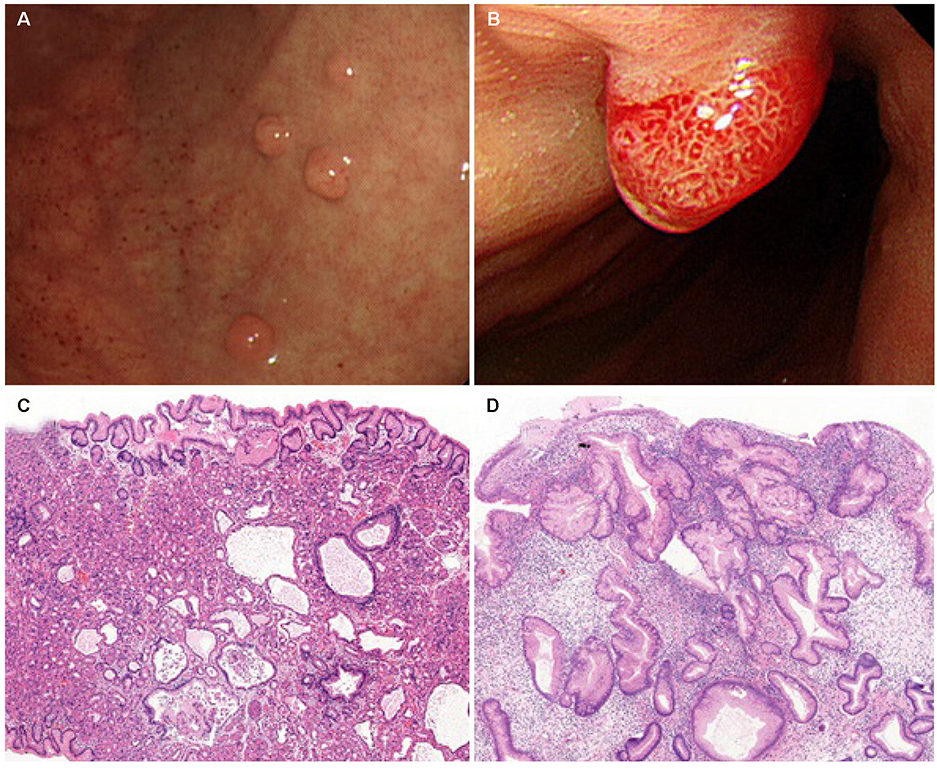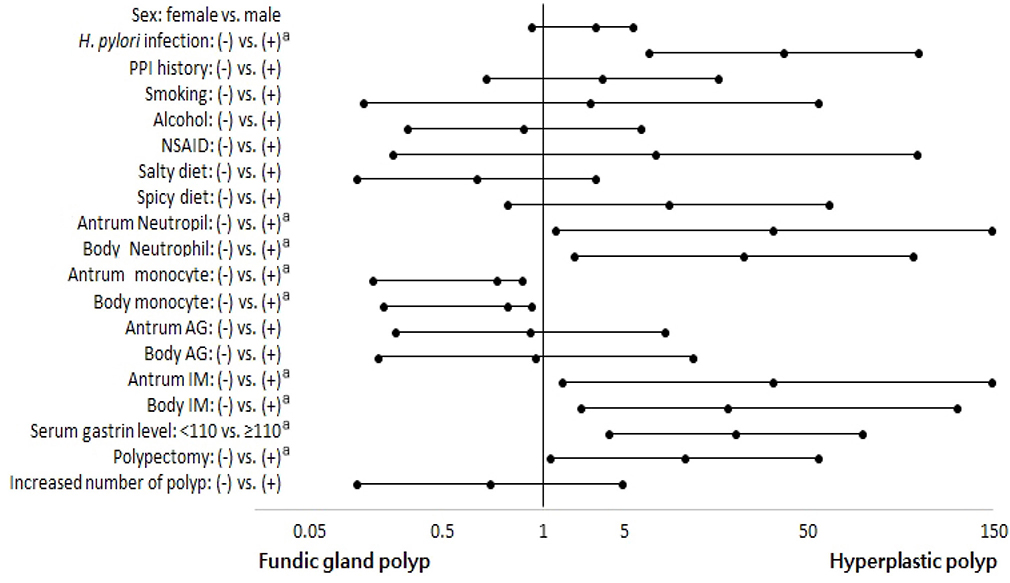Korean J Gastroenterol.
2019 Jul;74(1):17-29. 10.4166/kjg.2019.74.1.17.
Risk Factors of Multiple Gastric Polyps according to the Histologic Classification: Prospective Observational Cohort Study
- Affiliations
-
- 1Department of Internal Medicine, Seoul National University Bundang Hospital, Seoungnam, Korea. nayoungkim49@empas.com
- 2Department of Pathology, Seoul National University Bundang Hospital, Seoungnam, Korea.
- 3Department of Internal Medicine and Liver Research Institute, Seoul National University College of Medicine, Seoul, Korea.
- KMID: 2453255
- DOI: http://doi.org/10.4166/kjg.2019.74.1.17
Abstract
- BACKGROUND/AIMS
The aim of this study was to determine the risk factors of multiple gastric polyps according to the histological classification of gastric polyps.
METHODS
Subjects with multiple gastric polyps (at least three) during endoscopy were enrolled prospectively. They were assigned to a fundic gland polyp (FGP) group and hyperplastic polyp (HP) group based on a histological classification of gastric polyps. Helicobacter pylori (H. pylori) was confirmed by its histology. Serum gastrin was measured using the radioimmunoassay method. A questionnaire was taken regarding the intake of proton pump inhibitor and nonsteroidal anti-inflammatory drugs, alcohol, smoking history, and diet.
RESULTS
Among the 60 subjects enrolled from 2015 to 2018 at Seoul National University Bungdang Hospital, 47 and 13 subjects were assigned to the FGP and HP groups, respectively. The H. pylori infection rate was 12.8% in the FGP group, which is lower than that in the HP group (69.2%, p<0.001). The gastrin level was higher in the HP group (194.7 pg/dL, range 50.6-387.8 pg/dL) than in the FGP group (57.4 pg/dL, range 24.8-79.0 pg/dL) (p=0.007). Histologically, neutrophil infiltration in the antrum and body of the stomach were higher in the HP group than in the FGP group (p=0.022 and p=0.030, respectively). In contrast, monocyte infiltration in the antrum and body of the stomach were higher in the FGP group than in the HP group (p=0.018 and p<0.001, respectively).
CONCLUSIONS
HPs arise from inflammation caused by H. pylori. On the other hand, the FGP was not associated with H. pylori or environmental factors.
MeSH Terms
Figure
Cited by 1 articles
-
Causal Relationship: Development of Gastric Epithelial Polyp in Korea
Hyuk Lee
Korean J Gastroenterol. 2019;74(1):1-3. doi: 10.4166/kjg.2019.74.1.1.
Reference
-
1. Dekker W. Clinical relevance of gastric and duodenal polyps. Scand J Gastroenterol Suppl. 1990; 178:7–12.
Article2. Lee SW. Diagnosis and management of gastric polyps. Korean J Med. 2016; 90:307–312.
Article3. Goddard AF, Badreldin R, Pritchard DM, Walker MM, Warren B, British Society. The management of gastric polyps. Gut. 2010; 59:1270–1276.
Article4. Borch K, Skarsgård J, Franzén L, Mårdh S, Rehfeld JF. Benign gastric polyps: morphological and functional origin. Dig Dis Sci. 2003; 48:1292–1297.5. Stolte M, Sticht T, Eidt S, Ebert D, Finkenzeller G. Frequency, location, and age and sex distribution of various types of gastric polyp. Endoscopy. 1994; 26:659–665.
Article6. Sipponen P, Laxén F, Seppälä K. Cystic ‘hamartomatous’ gastric polyps: a disorder of oxyntic glands. Histopathology. 1983; 7:729–737.
Article7. Lee RG, Burt RW. The histopathology of fundic gland polyps of the stomach. Am J Clin Pathol. 1986; 86:498–503.
Article8. Haruma K, Sumii K, Yoshihara M, Watanabe C, Kajiyama G. Gastric mucosa in female patients with fundic glandular polyps. J clin gastroenterol. 1991; 13(5):565–569.
Article9. Odze RD, Marcial MA, Antonioli D. Gastric fundic gland polyps: a morphological study including mucin histochemistry, stereometry, and MIB-1 immunohistochemistry. Hum Pathol. 1996; 27:896–903.
Article10. Wu TT, Kornacki S, Rashid A, Yardley JH, Hamilton SR. Dysplasia and dysregulation of proliferation in foveolar and surface epithelia of fundic gland polyps from patients with familial adenomatous polyposis. Am J Surg Pathol. 1998; 22:293–298.
Article11. Jain R, Chetty R. Gastric hyperplastic polyps: a review. Dig Dis Sci. 2009; 54:1839–1846.
Article12. Han AR, Sung CO, Kim KM, et al. The clinicopathological features of gastric hyperplastic polyps with neoplastic transformations: a suggestion of indication for endoscopic polypectomy. Gut Liver. 2009; 3:271–275.
Article13. Stolte M. Hyperplastic polyps of the stomach: associations with histologic patterns of gastritis and gastric atrophy. Am J Surg Pathol. 2001; 25:1342–1344.
Article14. Carmack SW, Genta RM, Graham DY, Lauwers GY. Management of gastric polyps: a pathology-based guide for gastroenterologists. Nat Rev Gastroenterol Hepatol. 2009; 6:331–341.
Article15. Cao W, Hou G, Zhang X, San H, Zheng J. Potential risk factors related to the development of gastric polyps. Immunopharmacol Immunotoxicol. 2018; 40:338–343.
Article16. Park DY, Lauwers GY. Gastric polyps: classification and management. Arch Pathol Lab Med. 2008; 132:633–640.
Article17. Hongo M, Fujimoto K, Gastric Polyps. Incidence and risk factor of fundic gland polyp and hyperplastic polyp in long-term proton pump inhibitor therapy: a prospective study in Japan. J Gastroenterol. 2010; 45:618–624.
Article18. Burt RW. Gastric fundic gland polyps. Gastroenterology. 2003; 125:1462–1469.
Article19. Dixon MF, Genta RM, Yardley JH, Correa P. Classification and grading of gastritis. The updated Sydney system. International workshop on the histopathology of gastritis, Houston 1994. Am J Surg Pathol. 1996; 20:1161–1181.20. Korman MG, Strickland RG, Hansky J. Serum gastrin in chronic gastritis. Br Med J. 1971; 2:16–18.
Article21. Kim BC, Jung SW, Kim JB, et al. Serum gastrin levels in different stages of distal gastric carcinogenesis: is there a role for serum gastrin in tumor growth? Turk J Gastroenterol. 2014; 25:611–618.
Article22. Watson SA, Grabowska AM, El-Zaatari M, Takhar A. Gastrin - active participant or bystander in gastric carcinogenesis? Nat Rev Cancer. 2006; 6:936–946.
Article23. Jalving M, Koornstra JJ, Wesseling J, Boezen HM, DE Jong S, Kleibeuker JH. Increased risk of fundic gland polyps during long-term proton pump inhibitor therapy. Aliment Pharmacol Ther. 2006; 24:1341–1348.
Article24. el-Zimaity HM, Jackson FW, Graham DY. Fundic gland polyps developing during omeprazole therapy. Am J Gastroenterol. 1997; 92:1858–1860.25. Tran-Duy A, Spaetgens B, Hoes AW, de Wit NJ, Stehouwer CD. Use of proton pump inhibitors and risks of fundic gland polyps and gastric cancer: systematic review and meta-analysis. Clin Gastroenterol Hepatol. 2016; 14:1706–1719.e5.
Article26. Zelter A, Fernández JL, Bilder C, et al. Fundic gland polyps and association with proton pump inhibitor intake: a prospective study in 1,780 endoscopies. Dig Dis Sci. 2011; 56:1743–1748.
Article27. Martin FC, Chenevix-Trench G, Yeomans ND. Systematic review with meta-analysis: fundic gland polyps and proton pump inhibitors. Aliment Pharmacol Ther. 2016; 44:915–925.
Article28. Masaoka T, Suzuki H, Hibi T. Gastric epithelial cell modality and proton pump inhibitor. J Clin Biochem Nutr. 2008; 42:191–196.
Article29. Ally MR, Veerappan GR, Maydonovitch CL, et al. Chronic proton pump inhibitor therapy associated with increased development of fundic gland polyps. Dig Dis Sci. 2009; 54:2617–2622.
Article30. Cats A, Schenk BE, Bloemena E, et al. Parietal cell protrusions and fundic gland cysts during omeprazole maintenance treatment. Hum Pathol. 2000; 31:684–690.
Article31. Abraham SC, Singh VK, Yardley JH, Wu TT. Hyperplastic polyps of the stomach: associations with histologic patterns of gastritis and gastric atrophy. Am J Surg Pathol. 2001; 25:500–507.
Article32. Dirschmid K, Platz-Baudin C, Stolte M. Why is the hyperplastic polyp a marker for the precancerous condition of the gastric mucosa? Virchows Arch. 2006; 448:80–84.
Article33. Abraham SC, Nobukawa B, Giardiello FM, Hamilton SR, Wu TT. Fundic gland polyps in familial adenomatous polyposis: neoplasms with frequent somatic adenomatous polyposis coli gene alterations. Am J Pathol. 2000; 157:747–754.34. Toyooka M, Konishi M, Kikuchi-Yanoshita R, Iwama T, Miyaki M. Somatic mutations of the adenomatous polyposis coli gene in gastroduodenal tumors from patients with familial adenomatous polyposis. Cancer Res. 1995; 55:3165–3170.35. Koch A, Denkhaus D, Albrecht S, Leuschner I, von Schweinitz D, Pietsch T. Childhood hepatoblastomas frequently carry a mutated degradation targeting box of the beta-catenin gene. Cancer Res. 1999; 59:269–273.36. Abraham SC, Nobukawa B, Giardiello FM, Hamilton SR, Wu TT. Sporadic fundic gland polyps: common gastric polyps arising through activating mutations in the beta-catenin gene. Am J Pathol. 2001; 158:1005–1010.37. Foley EF, Jazaeri AA, Shupnik MA, Jazaeri O, Rice LW. Selective loss of estrogen receptor beta in malignant human colon. Cancer Res. 2000; 60:245–248.38. Singh S, Paraskeva C, Gallimore PH, Sheppard MC, Langman MJ. Differential growth response to oestrogen of premalignant and malignant colonic cell lines. Anticancer Res. 1994; 14:1037–1041.39. Woodson K, Lanza E, Tangrea JA, et al. Hormone replacement therapy and colorectal adenoma recurrence among women in the polyp prevention trial. J Natl Cancer Inst. 2001; 93:1799–1805.
Article40. Graham JR. Gastric polyposis: onset during long-term therapy with omeprazole. Med J Aust. 1992; 157:287–288.
Article41. Choudhry U, Boyce HW Jr, Coppola D. Proton pump inhibitor-associated gastric polyps: a retrospective analysis of their frequency, and endoscopic, histologic, and ultrastructural characteristics. Am J Clin Pathol. 1998; 110:615–621.
Article42. Vieth M, Stolte M. Fundic gland polyps are not induced by proton pump inhibitor therapy. Am J Clin Pathol. 2001; 116(5):716–720.
Article43. Peura DA, Metz DC, Dabholkar AH, Paris MM, Yu P, Atkinson SN. Safety profile of dexlansoprazole MR, a proton pump inhibitor with a novel dual delayed release formulation: global clinical trial experience. Aliment Pharmacol Ther. 2009; 30(10):1010–1021.
Article44. Hsu WH, Wu IC, Kuo CH, et al. Influence of proton pump inhibitor use in gastrointestinal polyps. Kaohsiung J Med Sci. 2010; 26:76–83.
Article45. Cao H, Qu R, Zhang Z, et al. Sporadic fundic gland polyps are not associated with proton pump inhibitors therapy but negatively correlate with Helicobacter pylori infection in China. Chin Med J. 2014; 127:1239–1243.46. Huang CZ, Lai RX, Mai L, Zhou HL, Chen HJ, Guo HX. Relative risk factors associated with the development of fundic gland polyps. Eur J Gastroenterol Hepatol. 2014; 26:1217–1221.
Article47. Wang FW, Young SC, Chen RY, et al. The Prevalence and risk factors of gastric polyp in asymptomatic patients receiving health examination. Gastroenterol Res Pract. 2018; 2018:9451905.
Article
- Full Text Links
- Actions
-
Cited
- CITED
-
- Close
- Share
- Similar articles
-
- Clinical Study on Duodenal Polyps Prevalence Submitted to Upper Gaatrointestinal Endoscopy
- Diagnosis and Management of Gastric Polyps
- Diminutive Colonic Polyps (Less than 5 mm in diameter) : Endoscopic and Histologic Study
- A Case of Gastric Hyperplastic Polyposis Associated with Colonic Hyperplastic Polyposis
- A clinical study on the eradication therapy on multiple gastric polyposis associated with H. pylori infection




